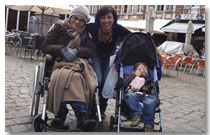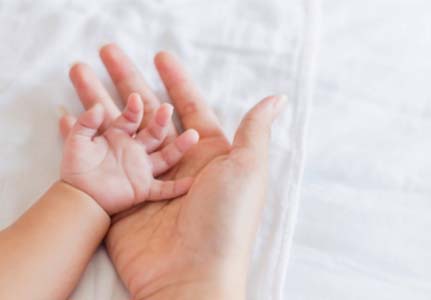CDG: Two stories, one shared hope
Liliana  was born in 1981, and diagnosed early with cerebral palsy. On one of her numerous hospital emergency visits, a neuro-paediatrician looked twice at the large spectrum of Liliana’s symptoms: strabismus, hypotonia, developmental delay, feeding problems, constant vomiting, inverted nipples, high fever, some unexplained unconscious states, etc., and investigated further. “Her blood samples revealed that she had CDG type I. My daughter was 16 years old, we were living in Lisbon and she was the first case reported in Portugal,” says Rosalia.
was born in 1981, and diagnosed early with cerebral palsy. On one of her numerous hospital emergency visits, a neuro-paediatrician looked twice at the large spectrum of Liliana’s symptoms: strabismus, hypotonia, developmental delay, feeding problems, constant vomiting, inverted nipples, high fever, some unexplained unconscious states, etc., and investigated further. “Her blood samples revealed that she had CDG type I. My daughter was 16 years old, we were living in Lisbon and she was the first case reported in Portugal,” says Rosalia.
MP was born in 2009 and was diagnosed with CDG six months later in their home town, Madrid. “Of course, we panicked,” explains Sandra, MP’s mother. “There was so little on the internet and no real support at the hospital. Nobody knew what CDG was and our questions were not answered. We were getting to know what it felt like to be a ‘rare’ family.” 27 years earlier, Rosalia found no support either and had a further disadvantage: most of the scientific information was in English and she doesn’t understand English well. “I really felt isolated,” says Liliana’s mother.
Congenital Disorders of Glycosylation (CDG) are a group of inherited disorders that affect glycosylation, which is a process by which all human cells build long sugar chains that are attached to proteins. Together the proteins and their attached sugars are called glycoproteins. Glycoproteins have many very important functions in the human body and are required for the normal growth and function of all tissues and organs. CDG is a very rare disease (prevalence is estimated to be between 1/50,000 and 1/100,000). In the last ten years, the number of known CDG cases has exceeded 800 patients worldwide, and despite its current frequency – (approximately 1 in every 20,000 to 50,000 infants), which in some regions, is close to the classical phenylketonuria (PKU), a rare metabolic disorder (frequency estimated at 1 in 15,000) very well known to paediatricians – clinical and public awareness of CDG needs improvement.
Sandra tracked down the Spanish CDG association which, together with the Portuguese CDG association, organises meetings, conferences and awareness programs on CDG. “They helped us a lot and we met other families who have the same experience.” Sandra trained and worked as an architect but with MP’s diagnosis, she had to put the work she loved aside. “MP has so many medical appointments, and therapy session each week that I had to stop working. Rehabilitation sessions 4 days a week, (2 hours per day minimum), then I have to take him to his school. I have only 4 hours free to come back home, do the cleaning, cook, go to supermarket, deal with the infinite bureaucratic processes that we have to deal with to get a special school, special social wealth assistance, and ask for national families budget support. Then, I pick him up again, come back home and accompany him in all the exercises his therapist has given him. I go to bed exhausted and I don’t get a lot of help at home. I’m an architect, I loved my work and I miss it a lot! At this moment, it is impossible for me to find a job. I don’t have a normal schedule anymore, and is quite important to support MP’s special needs. The problem is that now economically, is not easy to look to the future, at least when you are living in a country with a big financial crisis.”
 Rosalia had to set aside her dreams too. “I was 22 years old when Liliana was born and I had a lot of dreams! But my daughter was constantly sick and I could not pursue my ambitions. I even tried to look for a part-time job but could not find one,” recalls Rosalia. Life at home for her with a grown-up Liliana is still hard. “Everything runs in function of my daughter’s disease. And concerning specific installations, we tried to adapt the house as much as possible because my daughter is in a wheelchair, but this costs a huge amount of money so we cannot afford to have the house in optimal conditions for her.”
Rosalia had to set aside her dreams too. “I was 22 years old when Liliana was born and I had a lot of dreams! But my daughter was constantly sick and I could not pursue my ambitions. I even tried to look for a part-time job but could not find one,” recalls Rosalia. Life at home for her with a grown-up Liliana is still hard. “Everything runs in function of my daughter’s disease. And concerning specific installations, we tried to adapt the house as much as possible because my daughter is in a wheelchair, but this costs a huge amount of money so we cannot afford to have the house in optimal conditions for her.”
Liliana’s sister, Vanessa Ferreira, is now the president of the Portuguese CDG association as well as a member of the Spanish CDG association. “Vanessa gives me support in every aspect of my life and that of her sister’s. Liliana is very courageous and accepts her condition very bravely. She amazes me!” When asked about their hopes for the future, both mothers say clearly: “Treatment and cure for CDG patients!”
Read more:
CDG family story, Netherlands: www.tijmenholten.com / cdgpatient.blogspot.com
|
This article was first published in the October 2011 issue of the EURORDIS newsletter
Author: Nathacha Appanah
Photo credits: © Vanessa Ferreira


